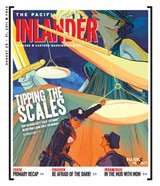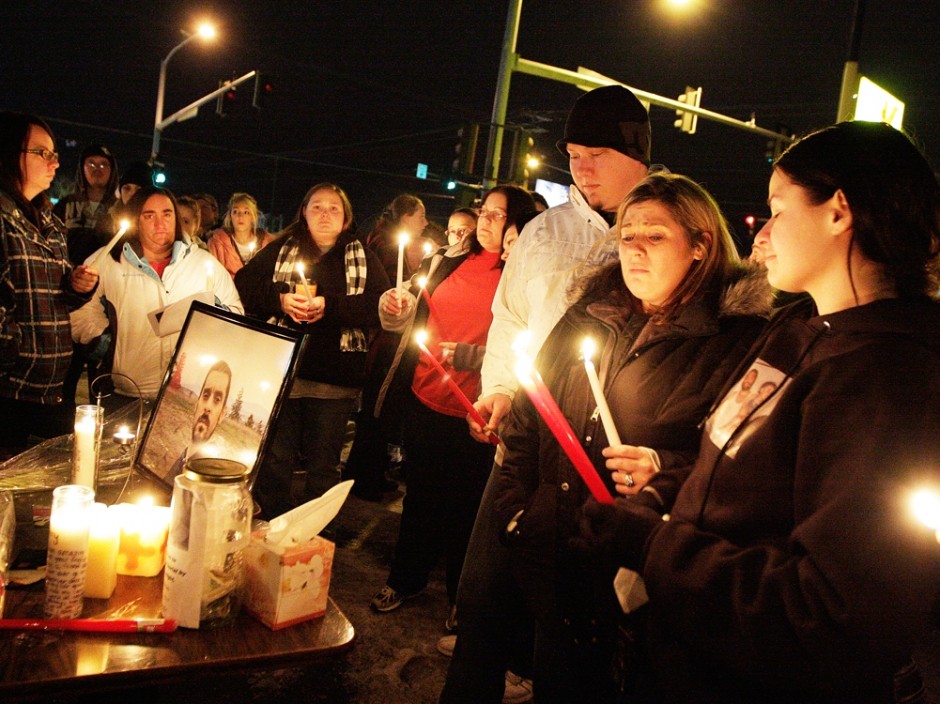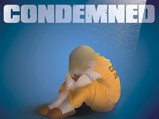Read the e-paper version
The Inlander is committed to exposing miscarriages of justice. Send tips and story ideas to injustice [at] inlander.com or call the news tip line at (509) 325-0634 ext. 264. Read more Injustice Project stories
Fred Rice is an authoritative man, particularly when it comes to explaining car crashes. The Idaho State Police officer’s eight-page résumé spells out his expertise. Thirty years in law enforcement. Experience investigating more than 800 wrecks, including 400 fatal ones. Twenty-six years as an expert witness in accident reconstruction.
Now, according to the Idaho Supreme Court, another line likely belongs on Rice’s résumé: perjury in a murder trial.
In 2006, Jonathan Ellington of Hayden, Idaho, stood accused of using his car to menace two young women and run over their mother, Vonette Larsen, while Larsen’s gun-wielding husband tried to stop him. The tragic case grew out of a wild road-rage incident and, in the end, underscores the power of expert witnesses in the courtroom.
Ellington, then 45, was a long-haul trucker and had been in trouble before, but not like this. He had been charged with driving under the influence twice and had received tickets for not wearing a seat belt, not having proof of insurance and speeding.
Ellington’s trial started on Aug. 23, 2006. The prosecutor called police officers, the medical examiner and Vonette Larsen’s family. Ellington’s lawyer called people who had encountered Ellington before the incident, as well as a firearms expert and an accident reconstructionist.
And then the prosecutor called Fred Rice. Over the objections of Ellington’s attorney, Rice took the stand to rebut the testimony of the defense’s accident investigator, who argued that Ellington didn’t intentionally strike Vonette Larsen. Rice countered that claim.
“I think that he was quite pivotal in the verdict,” says Anne Taylor, a Kootenai County deputy public defender. “Fred Rice had a definite presence in the courtroom. He’s a person who’s testified quite a bit before.”
The jury deliberated for a day and a half before finding Ellington guilty of aggravated assault and second-degree murder. He was sentenced to 25 years and would have to serve at least 12.
Ellington is still in jail, but no longer as a convicted murderer: In a ruling released at the end of May, the Idaho Supreme Court threw out his conviction and ordered that Ellington be given a new trial, which is scheduled to start on Monday, Aug. 29.
The state Supreme Court didn’t rule that the case was tainted by some legal technicality, but something much simpler: evidence that Rice lied on the stand.
The judges also found misconduct in the case by the Kootenai County prosecutor’s office, which has had several convictions tossed out in recent years because of similar issues.
“It
is extremely disturbing to this Court that an officer of the law would
present false testimony in any case, especially a murder case,” Justice
Warren Jones says in the Supreme Court decision (pdf). “In this case, however,
it is impossible to believe there was any truth to the testimony of
Cpl. Rice.”
It was New Year’s Day 2006, about 11 am. Stopped at the intersection of West Brunner and North Ramsey — a quiet intersection of two-lane country roads southwest of Athol, Idaho — were two cars: a white and gold Chevy Blazer driven by Ellington and a white Honda driven by Jovon Larsen, 22, with her sister, Joleen Larsen, 18, as a passenger.
In her testimony, Jovon Larsen says Ellington had been tailgating her, and then cut sharply back into their lane after passing them.
Ellington, who did not take the stand in the trial, says in court records that the girls were trying to cut him off and gave him the finger through the window.
While stopped at the intersection, Jovon Larsen later testified, Ellington got out of the Blazer, which was in front of the Honda, and punched the driver’s side window of the Honda as he yelled at the sisters. Then he drove off.
The Larsen sisters decided to follow him. His Blazer had no license plates, and Joleen Larsen testified that they wanted to ensure that he didn’t escape. As they chased him, they also called their parents.
At one point, Ellington turned around and drove past the Larsens’ oncoming car.
“I could see the mean look on his face,” Joleen Larsen testified, adding that he flipped them off as he drove by.
The
Larsen sisters tried to follow Ellington but couldn’t keep up, so they
did as instructed by a 911 dispatcher and pulled over to wait for a
Kootenai County sheriff’s deputy to arrive.
As they waited, their parents, Vonette Larsen and Joel Larsen, pulled up in a maroon Subaru. The sheriff’s deputy eventually arrived and gave them reports to fill out before leaving.
The incident didn’t end there. After the deputy left, the women’s parents continued to search for Ellington in their Subaru.
On Brunner Road, the Larsen couple pulled up to a woman as she was tending her donkeys. Joel Larsen got out of the car and asked if she had seen a Blazer drive by. In court, the woman described Larsen’s manner as “agitated, aggressive, antsy, angry,” adding that she was fearful of him. The woman told Joel Larsen that she had not seen the Blazer, and the couple left.
The Larsen couple soon spotted Ellington, and they, along with their daughters, began chasing him at speeds upwards of 90 miles per hour.
Joleen Larsen called 911, according to court records. A dispatcher told her to stop chasing Ellington, and Larsen said that they first wanted to see where he went when he got on nearby Highway 41. (The Larsen family, through prosecutors, declined to comment for this article.)
As the chase headed west on the quiet Scarcello Road, toward the highway, Ellington pulled into a private driveway and attempted to turn around. He slid on a snow bank before pulling back onto the road.
The two Larsen cars ended up colliding with the Blazer, according to court records. Joel Larsen testified that he thought Ellington was running over the Honda with his two daughters inside, so he got out of the Subaru and began shooting at the Blazer’s engine block with his .44 Magnum pistol.
Vonette Larsen exited the Subaru at the same time as her husband, and as she was running across the road toward the Blazer, Ellington accelerated, according to records.
In his testimony, Joel Larsen says Ellington “floored it.” His wife was struck and the Blazer’s tires crushed her head and torso. “The best way you can describe it is if you put a log over the road and drive over the top of it,” he testified.
Joel Larsen fired at the fleeing Blazer until his gun was empty.
Ellington was arrested later that day. The first magistrate to hear the case found that there was insufficient evidence to charge him with murder in the second degree and aggravated assault. Prosecutors re-filed the charges and got a hearing before a different magistrate, who upheld the charges.
After a jury found him guilty, Ellington was sentenced in December 2006 to 15 years each on two counts of aggravated assault and 25 years for the murder. According to the sentence, he would have to serve 12 years before he would be eligible for parole.
Ellington filed an appeal on Jan. 4, 2007. The appeal was handled by Deputy State Appellate Public Defender Erik Lehtinen, who argues cases before the Idaho Court of Appeals and the Idaho Supreme Court.
At the time, Lehtinen was handling another case where a man, Albert Ciccone, was appealing his conviction for murdering his wife and unborn child by running them over with his car. Rice had testified in that trial, so his name was familiar to Lehtinen as he examined Rice’s testimony in Ellington’s court file.
“In reading his testimony, it appeared incredible to me,” Lehtinen says of Rice. “It really struck me as being highly questionable testimony.”
In the Ellington case, Rice was called by prosecutors to rebut the testimony of Bill Skelton, an accident reconstruction expert hired by the defense.
Skelton testified that Ellington’s Blazer did not drive onto the hood of the Honda, that the debris field from the incident indicated that Ellington was in his proper lane of travel when he hit the Honda, and that based on the average perception and reaction time — a measurement of how fast someone can react to an obstacle suddenly in their path while driving — Ellington could not have reacted to the Honda or Vonette Larsen’s presence in front of his vehicle. In other words, he didn’t do it on purpose.
When Rice took the stand, he stated the opposite.
“There is no average reaction/perception time in the world,” Rice testified. “There are no two people who see things and react in the same way.”
Furthermore, a debris field cannot be used to accurately determine where an impact happened, he said.
“He’s wrong,” Skelton remembers thinking as Rice testified. “He’s definitely wrong.”
At the very least, Rice had contradicted himself. As Lehtinen discovered, Rice testified in the Ciccone trial that debris from the impact provides an accurate indication of where the crash happened.
And in training materials he had authored for the Idaho State Police, which were obtained by the public defenders through a records request, Rice had written that a perception and reaction time of 1.6 seconds is considered to be the average.
In the view of the Idaho Supreme Court, this amounted to lying in the service of winning a conviction.
“It
is abhorrent to this Court, as it would be to any other court, that a
man can be sentenced to twenty-five years for second-degree murder based
primarily on the false testimony of a trooper of this State,” the Idaho
Supreme Court wrote.
Four days after the court vacated Ellington’s conviction, the Idaho State Police put Rice, who earned a salary of $66,064 in 2010, on paid leave. This is standard procedure for this type of investigation, says State Police Capt. Clark Rollins. Depending on what the examination finds, he could face penalties up to termination, he says.
In a brief phone interview, Rice says he couldn’t talk about the case for fear of losing his job.
“I cannot comment except that I did nothing wrong,” Rice says. “I did not lie.”
Since the investigation has not been released, Capt. Steve Richardson, Rice’s commanding officer in Boise, declined to comment on Rice’s conduct.
Outside of penalties by his employer, Rice could face perjury charges if the State Police investigators prove he lied under oath. The person who would be responsible for filing charges against him is Kootenai County Prosecuting Attorney Barry McHugh.
McHugh declined to comment on whether he was planning to prosecute Rice.
When asked why Rice was chosen to testify in the investigation, McHugh says it was a matter of convenience.
“The case got going, we had a need for an expert, we know someone like Fred Rice, who was available, and [we] don’t have to pay for him,” when he’s acting in his official capacity as a police officer, McHugh says.
Expert witnesses in accident reconstruction are essentially small-business men. As a private side business, Rice maintains a website detailing his expertise, with an animation on the site showing him driving a truck into the side of a sedan as part of a staged accident.
“Fred can provide unbiased expert testimony in court of law, allowing Judges and Jurys [sic] to see what really took place,” the website reads.
Kurt Holzer, a personal injury attorney in Boise, says he occasionally hires accident reconstructionists in cases he litigates. But he is always careful with whom he hires.
“I have seen experienced witnesses say things that just make my jaw drop,” Holzer says.
There is a clear difference between a typical witness, Holzer says, and expert witnesses, who are allowed to offer opinions on evidence when testifying.
“The
reality of the courtroom is very different to somebody who’s testified
once or twice [than] to someone who testified 35 or 40 times,” Holzer
says. “I think that that power wears off on some of these people. For
some people, they lose sight of what it is that their role is and what
the role of the court is.”
Besides finding that Rice likely perjured himself, the Supreme Court also found a number of instances of misconduct by Kootenai County prosecutors. Deputy Prosecutor Arthur Verharen led the case against Ellington.
In one finding, the Supreme Court criticized prosecutors for persisting in asking Joel Larsen inflammatory questions about what Ellington did after hitting Larsen’s wife. This was after the judge had told the prosecutor to stop using such language.
“After defense counsel objected and the prosecutor was told by the court to ‘move on,’ the prosecutor immediately asked again what Mr. Larsen did ‘after Mr. Ellington ran over your wife,’” the court writes. This amounted to misconduct, the judges ruled.
In another instance, the court faulted both the prosecutor and sheriff’s Deputy Brad Maskell for an exchange regarding Ellington’s silence after he was arrested. That was misconduct, the court says, because it is improper for the prosecutor to ask about a defendant’s invoking of his Miranda rights. It is also improper for the officer to comment, they wrote.
The court also found misconduct in the prosecution’s questions to an audio analyst who enhanced 911tapes of the incident and subsequently quit his job. When the prosecutor asked why he quit, the analyst testified that it was because the disturbing nature of the tapes affected his sleep. That line of questioning was “highly prejudicial and irrelevant,” the court found.
The Supreme Court also took issue with District Court Judge John P. Luster for allowing prosecutors to use a diagram of the accident with the word “homicide.”
Nonetheless,
the court did not rule on whether the prosecutorial misconduct
warranted a new trial; Rice’s “false testimony” was sufficient to reach
that conclusion, they say.
Prosecutorial misconduct is not an unfamiliar finding when cases tried in Kootenai County go before a higher court.
“This case represents yet another in a long line or pattern of repetitious misconduct from this prosecutorial office,” wrote Court of Appeals Justice Pro Tem Alan Schwartzman in a 2007 opinion (pdf) overturning the aggravated assault conviction of Derek Phillips.
That case was overturned because Verharen, who prosecuted Phillips, told the jury during his closing argument that they should be “irritated” or “upset” by the witnesses’ version of events. The court threw out the conviction, and the charges were eventually dismissed against Phillips.
In the 2007 case of Sky Beebe, convicted of attempted robbery, the state Court of Appeals found that there was sufficient evidence to sustain a guilty verdict (pdf) but overturned it due to statements and characterizations made by Deputy Prosecutor Marty Rapp in the course of a trial. In a retrial, Beebe pled to a lesser charge and was released.
There are two types of prosecutorial misconduct, says Don Burnett, dean of the College of Law at the University of Idaho. Misconduct is harmless if the defendant would be convicted regardless. Misconduct is reversible if a conviction is won primarily due to that misconduct, Burnett says. But while there’s no such thing as a perfect trial, Burnett says committing misconduct is not the same thing as making a mistake.
“It is uncommon for a mistake to rise to the level of prosecutorial misconduct, even more uncommon for conviction to be set aside even solely or primarily on that basis,” says Burnett, who served on the Idaho Court of Appeals from 1982 to 1990.
Prosecuting Attorney McHugh, who came into office in January 2009, tells The Inlander in an email that he has spoken with the judges who found misconduct and with his own prosecutors to determine how his office could better stop that from happening.
“I will continue to do what I’ve been doing to make sure the prosecutors from this office, while aggressively pursuing criminal
cases, conduct themselves in a professional manner,” McHugh says. He adds that some of the misconduct came from the testimony of law enforcement officers, and he plans to work with those officers to ensure their testimony stands up if appealed.
Most
of these cases in which misconduct was found were tried when Bill
Douglas acted as county prosecuting attorney from 1988 to 2008. Douglas
declined to comment on this article.
The same cast of characters from 2006 is slated to appear at the courthouse on Monday. Taylor will be there, representing Ellington once again.
“My strategy is to prepare well and fight hard and do an excellent job for our client,” the deputy public defender says. “I believe Mr. Ellington is an innocent man.”
Verharen, along with another deputy prosecuting attorney, David Robins, will be there. McHugh says he will be supervising — though not directly participating — in the case and believes they can win a conviction again.
“I have every confidence in the ability of Mr. Verharen and Mr. Robins to prosecute this case effectively and appropriately,” McHugh says.
And Jonathan Ellington will be there. He has spent the last five years in jail, other than for five days between when the conviction was vacated and the charges were re-filed. After being freed, Ellington went to Utah and stayed with a relative there, Taylor says. When ordered back into custody, he took a bus all night to Coeur d’Alene so he could report to jail in time.
At the end of the trial, the facts of what happened that New Year’s Day will once again be weighed. What happened in the courtroom during the first trial remains under investigation.
“The
hard part for me is that Mr. Ellington [is] very lucky since I worked
on both cases,” Lehtinen says of his discovery of Rice’s contradicted
testimony. “I don’t know how else it could have been caught.”
Comments? Send them [email protected]
The Inlander is committed to exposing miscarriages of justice. Send tips and story ideas to injustice [at] inlander.com or call the news tip line at (509) 325-0634 ext. 264. Read more Injustice Project stories
INJUSTICE PROJECT
Unforgiven
After paying their debt to society, millions are still branded by their felony records. Leah Sottile
INJUSTICE PROJECT
Shot and Killed
Local law enforcement has killed four people in the past four months. Coincidence or a sign of the future? Staff
INJUSTICE PROJECT
Kid Crime, Adult Time
How “tough on crime” laws are failing our children. Kevin Taylor




























